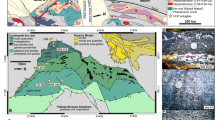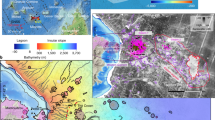Abstract
A large body of evidence exists for the break-up of an asteroid in the Middle Ordovician period (around 470 million years ago) and the rapid delivery of meteorites to the Earth, most notably recorded in meteorite-rich strata in Sweden1,2,3,4,5,6. The large number of meteorites at a single locality, spanning a relatively short time interval, implies a meteorite flux two orders of magnitude greater than at present7. Here I survey published data to show that the deposition of Middle Ordovician sedimentary megabreccias—consisting of large rock fragments dispersed in a fine matrix—was coincident with the high meteorite flux. The widespread distribution of such deposits reflects downslope movement of sediment and rock at continental margins on a global scale. My calculations show that this process could have been triggered by the seismic activity and destabilization of sediment slopes resulting from the high influx of meteorites. If so, the anomalous occurrence of megabreccias in the geological record may provide evidence for other episodes of enhanced meteorite delivery to the Earth.
This is a preview of subscription content, access via your institution
Access options
Subscribe to this journal
Receive 12 print issues and online access
$259.00 per year
only $21.58 per issue
Buy this article
- Purchase on Springer Link
- Instant access to full article PDF
Prices may be subject to local taxes which are calculated during checkout



Similar content being viewed by others
References
Schmitz, B., Peucker-Ehrenbrink, B., Lindström, M. & Tassinari, M. Accretion rates of meteorites and cosmic dust in the Early Ordovician. Science 278, 88–90 (1997).
Schmitz, B., Lindström, M., Asaro, F. & Tassinari, M. Geochemistry of meteorite-rich marine limestones strata and fossil meteorites from the lower Ordovician at Kinnekulle, Sweden. Earth Planet. Sci. Lett. 145, 31–48 (1996).
Schmitz, B., Tassinari, M. & Peucker-Ehrenbrink, B. A rain of ordinary chondritic meteorites in the early Ordovician. Earth Planet. Sci. Lett. 194, 1–15 (2001).
Schmitz, B., Häggström, T. & Tassinari, M. Sediment-dispersed extraterrestrial chromite traces a major asteroid disruption event. Science 300, 961–964 (2003).
Heck, P. R., Schmitz, B., Baur, H., Halliday, A. N. & Wieler, R. Fast delivery of meteorites to Earth after a major asteroid collision. Nature 430, 323–325 (2004).
Schmitz, B. et al. Asteroid breakup linked to the Great Ordovician biodiversification event. Nature Geosci. 1, 49–53 (2008).
Nesvorný, D., Vokrouhlický, D., Bottke, W. F., Gladman, B. & Häggström, T. Express delivery of fossil meteorites from the inner asteroid belt to Sweden. Icarus 188, 400–413 (2007).
Korochatseva, E. V. et al. L-chondrite asteroid breakup tied to Ordovician meteorite shower by multiple isochron 40Ar–39Ar dating. Meteorol. Planet. Sci. 42, 113–130 (2007).
Greenwood, R. C., Schmitz, B., Bridges, J. C., Hutchison, R. & Franchi, I. A. Disruption of the L chondrite parent body: New oxygen isotope evidence from Ordovician relict chromite grains. Earth Planet. Sci. Lett. 262, 204–213 (2007).
Bland, P. A. & Artemieva, N. A. The rate of small impacts on Earth. Meteorol. Planet. Sci. 41, 607–631 (2006).
Cocks, L. R. M. & Torsvik, T. H. Earth geography from 500 to 400 million years ago: A faunal and palaeomagnetic review. J. Geol. Soc. Lond. 159, 631–644 (2002).
Suuroja, K. et al. in Impact Markers in the Stratigraphic Record (eds Keoberl, C. et al.) 333–347 (Springer, 2003).
Ainsaar, L., Tinn, O. & Suuroja, K. in 9th Meeting of the Working Group on Ordovician Geology of Baltoscandia, Field Guide and Abstracts Vol. 7 (eds Ebbestad, J. O. R. et al.) (Sveriges Geologiska Undersökning, 2007).
James, N. P. & Stevens, R. K. Stratigraphy and correlation of the Cambro-Ordovician Cow Head Group, Western Newfoundland. Geol. Surv. Can. Bull. 366 (1986).
Clift, P. D. et al. Rapid tectonic exhumation, detachment faulting and orogenic collapse in the Caledonides of western Ireland. Tectonophysics 384, 91–113 (2004).
Archer, J. B. Llanvirn stratigraphy of the Galway-Mayo border area, western Ireland. Geol. J. 12, 77–98 (1977).
Jackson, D. E. & Lenz, A. C. The sequence and correlation of Early Ordovician (Arenig) graptolite faunas in the Richardson Trough and Misty Creek Embayment, Yukon Territory and District of Mackenzie, Canada. Can. J. Earth Sci. 43, 1791–1820 (2006).
Pyle, L. J. & Barnes, C. R. Lower Paleozoic stratigraphic and biostratigraphic correlations in the Canadian Cordillera: Implications for the tectonic evolution of the Laurentian margin. Can. J. Earth Sci. 40, 1739–1753 (2003).
Cooper, A. H. et al. The Skiddaw Group of the English Lake District (Memoir, British Geological Survey, 2004).
Woodcock, N. H. & Morris, J. H. in In Sight of the Suture: the Palaeozoic Geology of the Isle of Man in its Iapetus Ocean Context (eds Woodcock, N. H., Quirk, D. G., Fitches, W. R. & Barnes, R. P.) 121–138 (Geological Society Special Publication 160, The Geological Society, 1999).
Brück, P. M. & Vanguestaine, M. An Ordovician age for the Muggort’s Bay Lower Palaeozoic inlier, County Waterford, Ireland—the southernmost exposure of the Irish Caledonides. Geol. J. 40, 519–544 (2005).
Kokelaar, B. P., Bevins, R. E. & Roach, R. A. Submarine silicic volcanism and associated sedimentary and tectonic processes, Ramsay Island, SW Wales. J. Geol. Soc. Lond. 142, 591–613 (1985).
Todd, S. P., Connery, C., Higgs, K. T. & Murphy, F. C. An Early Ordovician age for the Annascaul Formation of the SE Dingle Peninsula, SW Ireland. J. Geol. Soc. Lond. 157, 823–833 (2000).
Heredia, S. & Beresi, M. S. La Formación Empozada y su relación estratigráfica con la Formación Estancia San Isidrio (nom. nov.), Ordovícico de la Precordillera de Mendoza. Rev. Asoc. Geol. Argent. 59, 178–192 (2004).
Gleason, J. D., Finney, S. C., Peralta, S. H., Gehrels, G. E. & Marsaglia, K. M. Zircon and whole-rock Nd–Pb isotopic provenance of Middle and Upper Ordovician siliciclastic rocks, Argentine Precordillera. Sedimentology 54, 107–136 (2007).
Thomas, W. A. & Astini, R. A. Ordovician accretion of the Argentine Precordillera terrane to Gondwana: A review. J. South Am. Earth Sci. 16, 67–79 (2003).
Cluzel, D., Cadet, J-P. & Lapierre, H. Geodynamics of the Ogcheon Belt (South Korea). Tectonophysics 183, 41–56 (1990).
Ryu, I. C., Oh, C. W. & Kim, S. W. A Middle Ordovician drowning unconformity on the northeastern flank of the Okcheon (Ogcheon) Belt, South Korea. Gondwana Res. 8, 511–528 (2005).
Meng, X., Ge, M. & Tucker, M. E. Sequence stratigraphy, sea-level changes and depositional systems in the Cambro-Ordovician of the North China carbonate platform. Sedim. Geol. 114, 189–222 (1997).
O’Brien, B. H., Swinden, H. S., Dunning, G. R., Williams, S. H. & O’Brien, F. H. C. A Peri-Gondwanan arc-back arc complex in Iapetus: Early-Mid Ordovician evolution of the Exploits Group, Newfoundland. Am. J. Sci. 297, 220–272 (1997).
Bergstrom, S. M. Whiterockian (Ordovician) conodonts from the Hølonda Limestone of the Trondheim region, Norwegian Caledonides. Norsk Geol. Tidds. 59, 295–307 (1979).
Ryan, P. D., Williams, D. M. & Skevington, D. in The Caledonides in the USA (ed. Wones, D. R.) 99–103 (I.G.C.P., 1980).
Zhen, Y. Y. & Percival, I. G. Middle Ordovician (Darriwilian) conodonts from allochthnonous limestones in the Oakdale Formation of central New South Wales. Alcheringa 28, 77–111 (2004).
Zhou, Z., Dean, W. T. & Huilin, L. Early Ordovician trilobites from Dali, West Yunnan, China, and their palaeogeographical significance. Palaeontology 41, 429–460 (1998).
Zimmermann, U. & Bahlburg, H. Provenance analysis and tectonic setting of the Ordovician clastic deposits in the southern Puna Basin, NW Argentina. Sedimentology 50, 1079–1104 (2003).
Bahlburg, H., Breitkreuz, C. & Zeil, W. in The Southern Central Andes (eds Bahlburg, H., Breitkreuz, Ch. & Giese, P.) 71–85 (Springer, 1988).
Gonzalez, J., Niemeyer, H., Benedetto, J. L. & Brussa, E. D. The Ordovician Quebrada Grande Formation, Cordon de Lila (Antofagasta Region, northern Chile): stratigraphic and paleogeographic significance. Rev. Geol. Chile 34, 277–290 (2007).
Dumoulin, J. A., Harris, A. G., Gagiev, M., Bradley, D. C. & Repetski, J. E. Lithostratigraphic, conodont, and other faunal links between lower Paleozoic strata in northern and central Alaska and northeastern Russia. Geol. Soc. Am. Spec. Paper 360, 291–312 (2002).
Enig, C. C. & Gutiérrez-Marco, J. G. Signification des niveaux à lingulidés à la limite supérieure du Grès Armoricain (Ordovicien, Arenig, sud-ouest de L’Europe). Geobios 30, 481–495 (1997).
Dypvik, H. & Jansa, L. F. Sedimentary signatures and processes during marine bolide impacts: A review. Sedim. Geol. 161, 309–337 (2003).
Morrow, J. R., Sandberg, C. A. & Harris, A. G. Late Devonian Alamo Impact, southern Nevada, USA: Evidence of size, marine site, and widespread effects. Geol. Soc. Am. Spec. Paper 384, 259–280 (2005).
Day, S. & Maslin, M. Linking large impacts, gas hydrates, and carbon isotope excursions through widespread sediment liquefaction and continental slope failure: The example of the K–T boundary event. Geol. Soc. Am. Spec. Paper 384, 239–258 (2005).
Spence, G. H. & Tucker, M. E. Genesis of limestone megabreccias and their significance in carbonate sequence stratigraphic models: A review. Sedim. Geol. 112, 163–193 (1997).
Drzewiecki, P. A. & Simó, J. A. Depositional processes, triggering mechanisms and sediment composition of carbonate gravity flow deposits: Examples from the Late Cretaceous of the south-central Pyrenees, Spain. Sedim. Geol. 146, 155–189 (2002).
Hine, A. C. et al. Megabreccia shedding from modern, low-relief carbonate platforms, Nicaraguan Rise. Geol. Soc. Am. Bull. 104, 928–943 (1992).
Bralower, T. J., Paull, C. K. & Leckie, R. M. The Cretaceous-Tertiary boundary cocktail: Chicxulub impact triggers margin collapse and extensive sediment gravity flows. Geology 26, 331–334 (1998).
Glikson, A. Y. Field evidence of Eros-scale asteroids and impact-forcing of Precambrian geodynamic episodes, Kaapvaal (South Africa) and Pilbara (Western Australia) Cratons. Earth Planet. Sci. Lett. 267, 558–570 (2008).
Wilson, R. C. & Keefer, D. K. Predicting areal limits of earthquake-induced landsliding. US Geol. Surv. Prof. Paper 1360, 316–345 (1985).
Astini, R. A. in The Proto-Andean Margin of Gondwana (eds Pankhurst, R. J. & Rapela, C. W.) 11–33 (Geological Society Special Publication 142, The Geological Society, 1998).
Gradstein, F. M., Ogg, J. G. & Smith, A. G. A Geologic Time Scale (Cambridge Univ. Press, 2004).
Acknowledgements
I acknowledge helpful reviews by B. Schmitz and M. Wendorff, discussion with G. Walkden and B. Cronin, and valuable technical support from B. Fulton.
Author information
Authors and Affiliations
Corresponding author
Supplementary information
Supplementary Information
Supplementary Information (PDF 80 kb)
Rights and permissions
About this article
Cite this article
Parnell, J. Global mass wasting at continental margins during Ordovician high meteorite influx. Nature Geosci 2, 57–61 (2009). https://doi.org/10.1038/ngeo386
Received:
Accepted:
Published:
Issue Date:
DOI: https://doi.org/10.1038/ngeo386
This article is cited by
-
Valuation of debris flow mitigation measures in tourist towns: a case study on Hongchun gully in southwest China
Journal of Mountain Science (2016)



